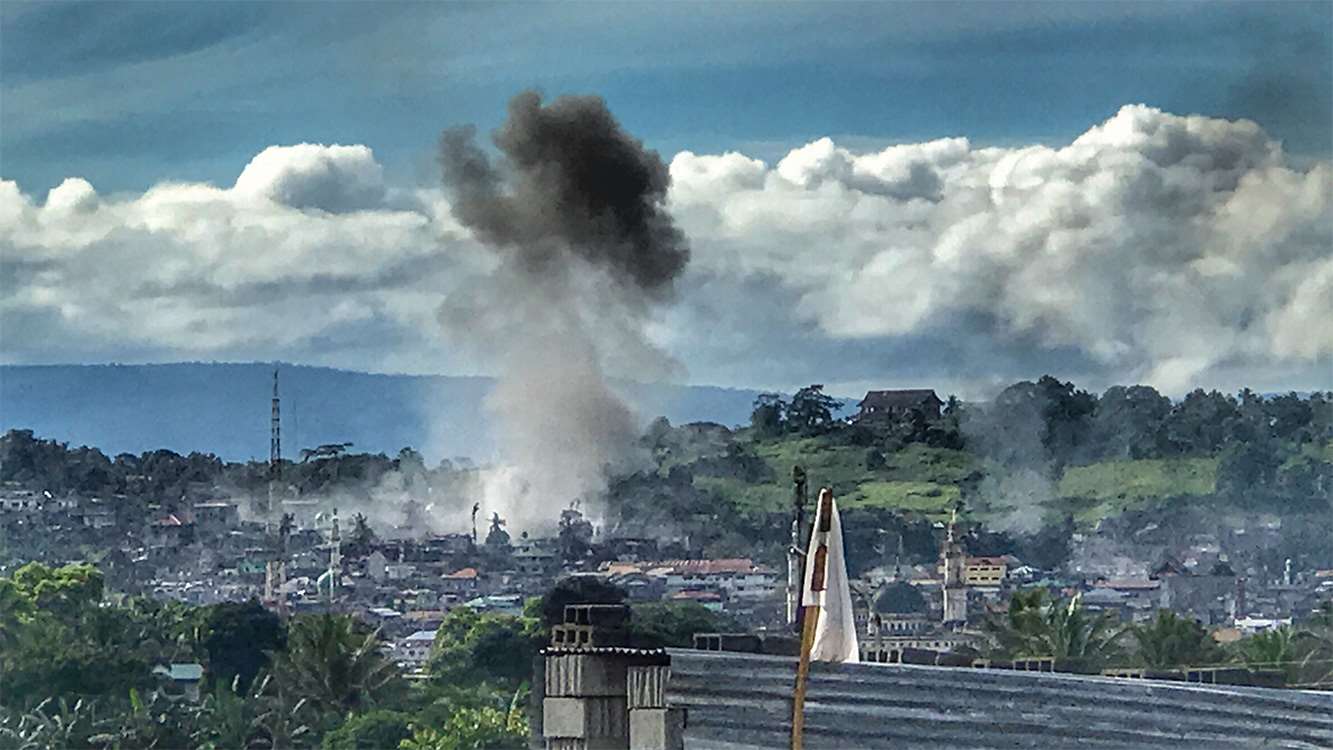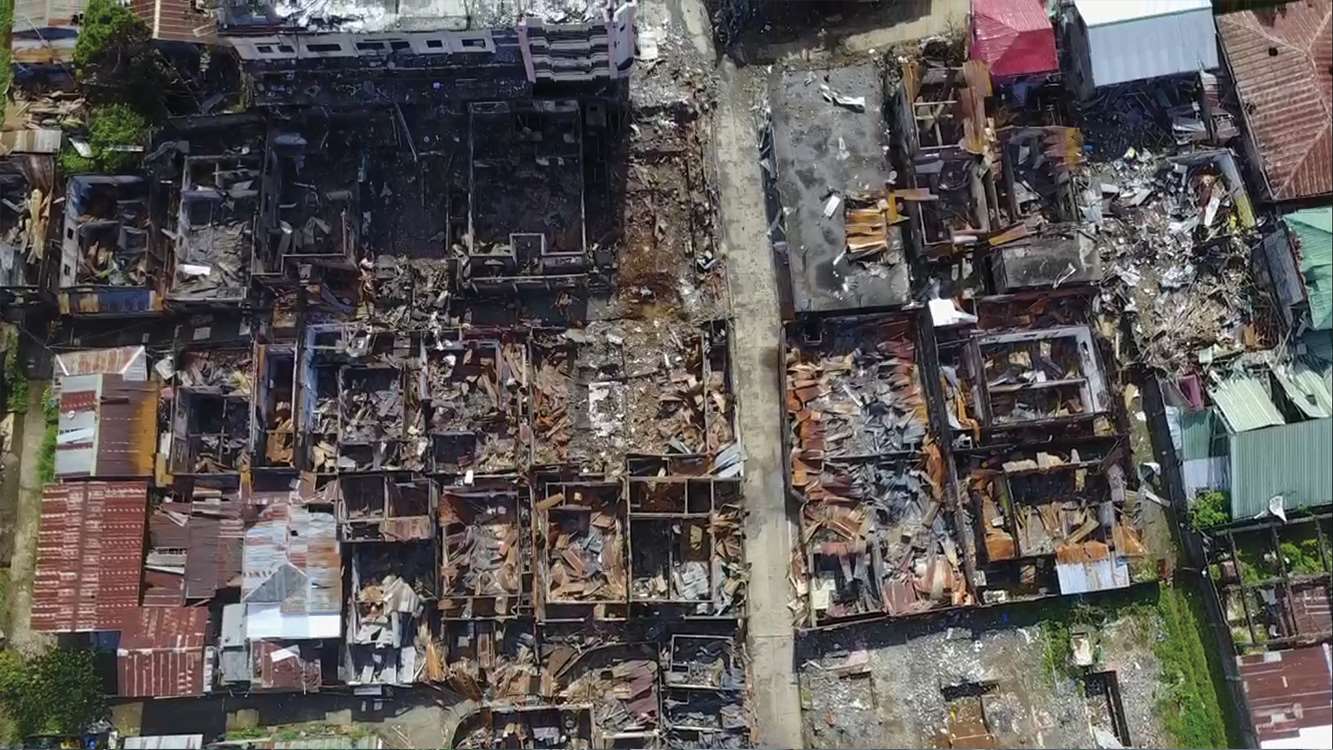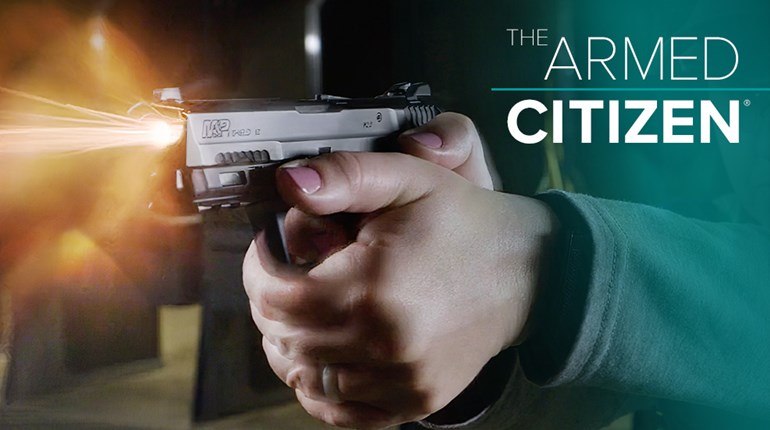
Incoming rounds sound different than outgoing ones. It isn’t a comforting sound.
My field producer Dennis and I were standing on a fourth-floor rooftop overlooking the city of Marawi, on the island of Mindanao, Southern Philippines. A month earlier, 500 or so terrorists who had aligned themselves with ISIS took over the city of 200,000, proclaiming an Islamic caliphate in a country that is more than 90 percent Catholic.
The Philippine army was besieging the city, and a haze of smoke wafted on the breeze as government forces bombed insurgent positions. The sounds of heavy fighting—machine guns, grenades, mortars and 100-pound bombs—drifted to where we were standing, about two kilometers from the city center. From that distance, we could get a fantastic view of the action.

I decided to record a standup for the “Frontlines” episode we were filming. Dennis set up with his zoom lens and I started the voice recorder in my pocket.
“This rooftop I’m standing on is only about two kilometers from the forward line of troops…”
… Zip … A round passed over my head. Close enough for the camera to record the sound of its passing.
Just a stray, I thought. I kept talking.
“We’re hearing bullets go by here as I speak. And there’s a massive volume of fire …”
We scrambled down off the roof with due haste, exceedingly grateful that ISIS snipers don’t get the training that U.S. snipers do.A moment later I finished the standup, then turned to look at the city as Dennis shut off the camera. My voice recorder was still rolling, though, and just as I turned back to Dennis and said, “Dude, that was a bullet!” it recorded the sound of three more rounds sailing by, closer than the last. One skittered off the rooftop to my left.
Everyone hit the deck. Someone was deliberately targeting us. It was a very bad feeling, since there was no cover on the rooftop and we had left our body armor in the car.
We scrambled down off the roof with due haste, exceedingly grateful that ISIS snipers don’t get the training that U.S. snipers do. Otherwise, they wouldn’t have missed.
Back on the ground, we finally got cleared to move up to the front lines inside the city, accompanying a squad from the Philippine 1st Infantry Battalion. We donned our body armor (better late than never) and loaded into an army truck for the short ride into the war-torn neighborhoods along the river that divides the city in two. It had become the dividing line between friendly and enemy troops since about the second day of the conflict. The three bridges that cross the river were blocked on both sides and swept by fire from hidden ISIS snipers. Most of the buildings along the river were all but destroyed.
We were met by Col. Christopher Tampus, commander of the 1st Batallion. A very likable and jovial man, he welcomed our questions and gladly took us into one of the buildings facing the river where they had a counter-sniper position. Two snipers peered through spider holes on a balcony, overlooking enemy positions only 200 meters away.
Col. Tampus crouched on the balcony and swept his hand across the battlefield. “They have so many places to hide, and they can change positions so quickly. It’s a real challenge to find them.”
As he spoke, one of his snipers piped up, “Movement in the green high-rise.” He adjusted a high-powered scope. “Muzzle blast there.”
Tampus picked up a pair of binoculars and surveyed the building in question. “Take the shot,” he said.
The soldier pushed the barrel of his .50-caliber sniper rifle out the spider hole—a fact that probably saved my eardrums once he pulled the trigger. The other sniper on his left also fired several rounds. Moments later a single-engine aircraft buzzed overhead, looking like a WWII prop-engine fighter. It turned out to be a 70’s-era Italian SF.260, which had been pressed into service against the insurgents. The plane dropped a single 110-pound bomb, which slammed into a building to our front, though not the one in which the enemy snipers had been spotted.
But otherwise, the work of ISIS in the Philippines looks very much like the work of ISIS in Iraq, Syria, Libya and elsewhere.Tampus shrugged. “These buildings are built very strong, reinforced concrete. The bombs don’t always do much good. But we keep after the enemy however we can.”
I asked why the buildings were fortified in the first place.
“This area has seen a lot of fighting over the past 20 years,” he said. “People build their houses to be able to protect themselves from it.”
Having spent time covering the fight against ISIS in Mosul, Iraq, I was struck by some of the differences here in the Philippines. First was the lack of suicide attacks, which have been so devastating to Iraqi troops retaking Mosul. So far the Philippine army had seen no VBIEDs or Jihadis with suicide vests. This indicates the insurgents in this fight, most of whom are local boys who used to call themselves Abu Sayyef, the Moro Islamic Liberation Front, Jemaah Islamiyah, or any number of other Muslim terrorist groups, maybe aren’t completely on board with ISIS’s preferred tactics to achieve a worldwide caliphate.
They have, however, proven to be perfectly willing to behead civilians, take hapless local women into sexual slavery, employ human shields and conscript boys as young as 10 to fight for them.

In many ways, Marawi is a micro-Mosul. It is only one-tenth the size, and still a beautiful city (Mosul was never beautiful). But otherwise, the work of ISIS in the Philippines looks very much like the work of ISIS in Iraq, Syria, Libya and elsewhere. It has resulted in wholesale destruction, hardship and suffering. It has caused a huge humanitarian crisis, too—more than 300,000 people have been displaced from their homes, many of whom will find they have nothing to return to when this is over.
The Philippine army has lost more than 70 troops as of this writing. It is expected the civilian death toll will top 100.
Hopefully not one of the terrorists will make it out alive.
As we were leaving the counter-sniper position, we got word that three people had just made a successful escape from the enemy-held area by crossing one of the bridges, under fire from ISIS. We met them about 100 meters from the bridge. They were still winded and nearly hysterical with fear. They flinched with every distant explosion or gunshot.
Col. Tampus sat them down on a street sheltered from enemy fire and had them rest and take some water while his men peppered the two men and one old woman with questions. The three were Catholics who had been held hostage for more than a month. The men had been made to dig fortifications and do other slave labor. They had been completely isolated from the outside world. The first thing the woman wanted was a way to charge her phone so she could let her family know she was alive.
It will probably be several more weeks at least before Marawi is completely secured. But members of the ISIS-backed groups claim they will be back. They say this is only the beginning.
But the inhabitants of Marawi, most of whom are Muslim, have had enough. Visiting several scattered camps of refugees outside the city, the former inhabitants vowed never to support the insurgency.
Let’s hope they keep that promise.
Chuck Holton is a veteran Army ranger and NRATV correspondent.

































